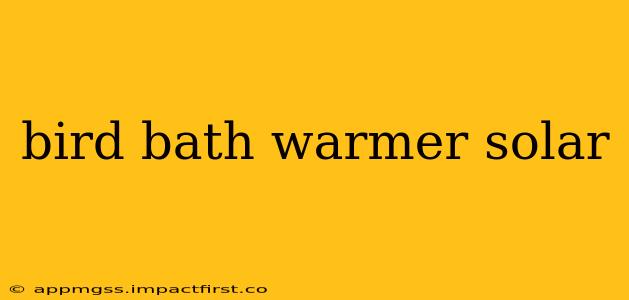Winter's chill can make finding a refreshing drink a challenge for our avian friends. A frozen bird bath renders it useless, potentially endangering birds who rely on it for hydration and cleaning. That's where a solar bird bath warmer comes in. This handy device utilizes the power of the sun to keep your bird bath ice-free, providing a vital lifeline for birds throughout the colder months. This guide will explore the benefits, considerations, and frequently asked questions surrounding solar bird bath warmers.
How Do Solar Bird Bath Warmers Work?
Solar bird bath warmers use photovoltaic cells, similar to those found in solar panels, to convert sunlight into electricity. This electricity then heats a heating element located within or beneath the bird bath, preventing the water from freezing. The warmer's efficiency depends on the intensity and duration of sunlight; sunny days will provide optimal performance. They're a simple, eco-friendly solution to a common winter problem.
What are the Benefits of Using a Solar Bird Bath Warmer?
Using a solar bird bath warmer offers several key advantages:
- Keeps birds hydrated: This is the most crucial benefit. Providing a reliable source of unfrozen water helps birds survive the harsh winter months, particularly when natural water sources freeze.
- Environmentally friendly: Solar power is a clean and sustainable energy source, minimizing your environmental impact compared to using electricity directly.
- Easy to install: Most solar bird bath warmers are designed for easy installation and require minimal effort to set up.
- Cost-effective: While the initial cost may vary, the ongoing operational cost is negligible as it relies on free sunlight.
- Attracts a wider variety of birds: A readily available water source attracts more birds to your garden, enhancing your birding experience.
What are the Different Types of Solar Bird Bath Warmers?
There's a range of solar bird bath warmers available, differing mainly in design and heating element placement:
- Submersible heaters: These are placed directly in the bird bath water. They’re usually quite compact and easy to hide.
- Under-bath heaters: These sit beneath the bird bath, heating it from below. This design can be more aesthetically pleasing.
- Integrated heaters: Some bird baths are designed with solar heating elements integrated directly into their construction, offering a sleek, all-in-one solution.
How Long Does a Solar Bird Bath Warmer Last?
The lifespan of a solar bird bath warmer varies depending on the quality of materials and the level of exposure to the elements. However, with proper care and maintenance, many can last for several years. Check the manufacturer’s warranty for specific details.
How Effective Are Solar Bird Bath Warmers in Extremely Cold Weather?
The effectiveness of a solar bird bath warmer depends largely on the intensity of the sunlight and the ambient temperature. In extremely cold climates or during periods of prolonged cloud cover, the warmer may not be able to prevent freezing entirely. In such cases, consider supplementing with an alternative heating method or choosing a model with a higher wattage.
Do Solar Bird Bath Warmers Require Any Maintenance?
Regular cleaning is essential to maintain the efficiency of your solar bird bath warmer. Remove any debris or algae buildup from the photovoltaic cells and the heating element to ensure optimal solar energy absorption. Refer to the manufacturer's instructions for specific cleaning recommendations.
Are Solar Bird Bath Warmers Safe for Birds?
Reputable solar bird bath warmers are designed with bird safety in mind. The heating elements are usually low voltage and designed to prevent overheating or scalding. Always choose a model from a reliable brand and follow the manufacturer's instructions for safe installation and usage.
Conclusion
Providing a consistent source of water for birds during the winter is a rewarding act of kindness. A solar bird bath warmer offers a practical, eco-friendly, and relatively inexpensive way to keep your feathered friends happy and healthy throughout the colder months. By carefully considering the different types available and following the maintenance instructions, you can ensure your birds have access to life-saving water all year round.
